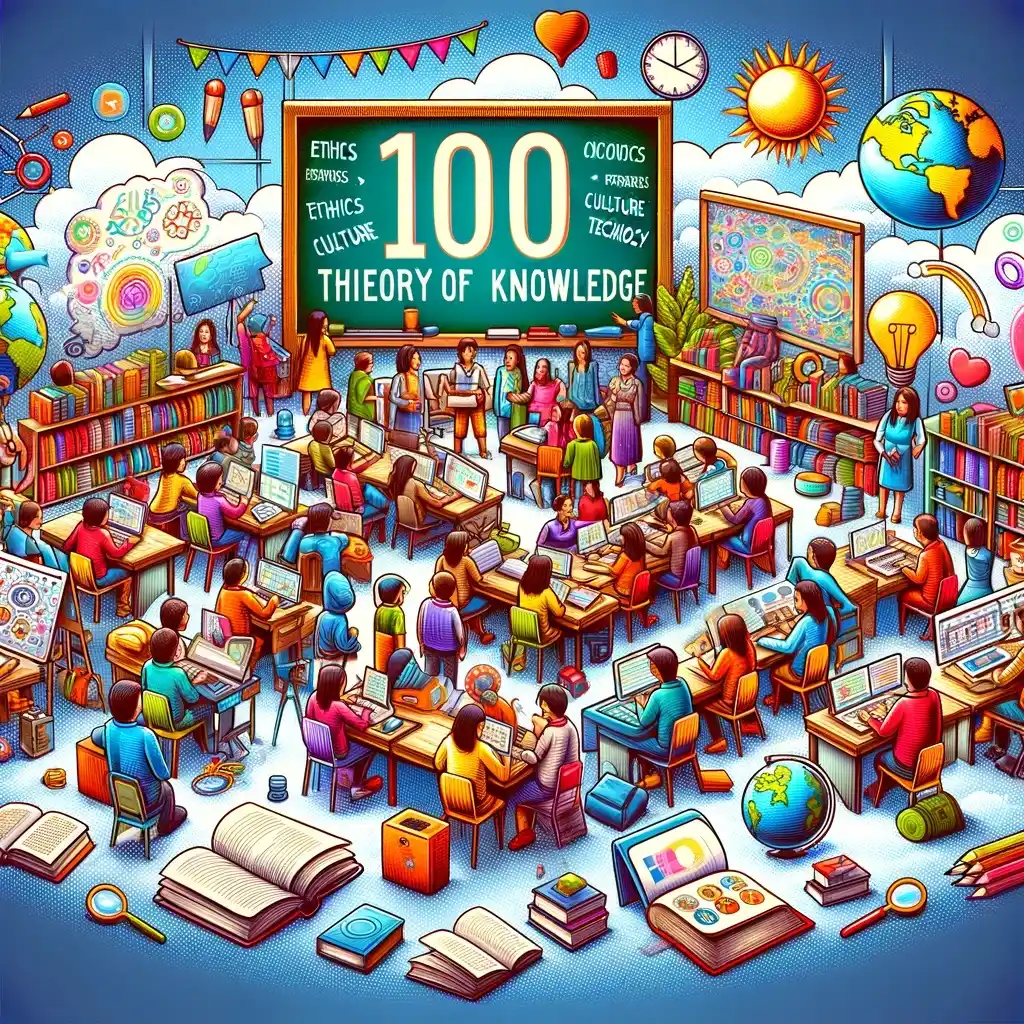1. Knowledge and the Knower- Critically evaluating knowledge through the knowledge framework component of perspectives
Activity: Role-Play Different Epistemologies-Creating a “Mary’s Room” activity for learners can be an engaging way to explore complex philosophical concepts in a classroom setting. Here’s a step-by-step guide to designing this activity:
Procedure: Assign students different epistemological perspectives (rationalism, empiricism, constructivism, etc.) Students role-play these perspectives in a discussion or debate, defending how their assigned perspective views the acquisition and validation of knowledge.
Learning objectives: To understand different epistemological theories and their implications.
To help students understand the concepts of subjective experience, qualia, and the limits of objective knowledge through an interactive exploration of the “Mary’s Room” thought experiment.
Materials Needed: A classroom or space that can be temporarily modified to simulate a monochromatic environment. (Monochromatic images, objects, or videos. Colourful objects or images to be revealed later. Handouts or slides with information about the thought experiment)
Activity Steps
- Introduction to the Concept
- Start by introducing the concept of “Mary’s Room” and its significance in the philosophy of mind.
- Explain key terms like ‘qualia’, ‘physicalism’, and ‘experiential knowledge.’
- Setting Up ‘Mary’s Room’
- Arrange the classroom or a section of it to simulate Mary’s monochromatic room. Use black and white or grayscale items only.
- This setup should lack any color to mimic Mary’s experience.
- Engagement Phase
- Have students spend some time in the ‘room,’ interacting with monochromatic objects, images, or videos.
- During this phase, encourage them to think about and discuss what they know about color without having experienced it.
- Revelation Phase
- Introduce colorful objects or images into the room.
- Allow students to experience the contrast and have an ‘aha’ moment similar to what Mary would experience upon seeing color for the first time.
- Discussion and Reflection
- Facilitate a discussion about the experience. Ask questions like:
- “Did seeing color add to your understanding? How?”
- “Can all knowledge be conveyed through objective information?”
- “How does this relate to the difference between knowing how and knowing that?”
- Encourage students to reflect on the limitations of objective knowledge and the role of subjective experience.
Linking to TOK Concepts
- Connect the activity back to core TOK concepts, such as ways of knowing, areas of knowledge, and the nature of knowledge itself.
- Discuss how this experiment challenges the notion of what can be known and how we come to know it.
Debrief and Wrap-Up
- Summarize key learnings and takeaways from the activity.
- Encourage students to think about other scenarios or fields where the distinction between experiential and factual knowledge is significant.
Conclusion
This activity not only provides an immersive experience into a fundamental philosophical thought experiment but also deepens students’ understanding of the complexities and nuances of knowledge. It’s an effective way to bridge abstract concepts with tangible experiences, making the learning process more engaging and memorable.
2. TOK concepts
Activity: Creating an Image Web on 12 TOK concepts
Objective: This activity aims to help students visualize and understand the interconnectedness of the 12 core concepts in the Theory of Knowledge (TOK) curriculum, facilitating a deeper comprehension of how these concepts influence and relate to each other.
Materials Needed:
- Large sheet of paper or a digital drawing tool
- Colored markers or digital drawing equivalents
- Ruler (for precise lines)
Procedure:
- Preparation:
- Identify the 12 TOK concepts: Knowledge, Belief, Truth, Justification, Evidence, Interpretation, Values, Perspectives, Culture, Power, Responsibility, and Objectivity.
- Prepare a large sheet or a digital space for drawing.
- Drawing Circles:
- Draw 12 circles, each representing a different TOK concept. Arrange them in a visually appealing and logical manner, such as in a circular pattern or a web-like network.
- Connecting Concepts:
- Draw lines to connect concepts that have direct relationships. For example, draw a line between ‘Evidence’ and ‘Truth.’
- Make sure the lines are drawn in a way that the overall structure is clear and uncluttered.
- Adding Descriptions:
- Next to each connecting line, write a brief phrase or keyword that encapsulates the nature of the relationship. For instance, beside the line between ‘Evidence’ and ‘Truth,’ you might write “validates” or “supports.”
- Using Colors and Symbols:
- Use different colors or symbols to distinguish between types of relationships, such as causal, correlative, or contrasting.
- This visual distinction helps in quickly identifying the nature of the connections.
- Highlighting Central Themes:
- If central themes emerge, such as the impact of culture or ethical considerations, highlight these using a distinct color or by placing them at the center of the web.
- Illustrating Dynamic Relationships:
- For bidirectional relationships that indicate mutual influence, use double-sided arrows.
- This visual cue signifies the dynamic and often reciprocal nature of these conceptual relationships.
- Discussion and Reflection:
- Once the web is complete, facilitate a group discussion. Encourage students to reflect on what they have learned about the interplay of TOK concepts.
- Discuss how understanding these connections can provide a deeper insight into the nature of knowledge and its acquisition.
- Presentation:
- Allow students to present their interpretation of the concept web, explaining the rationale behind the connections they have drawn.
- This presentation can be an individual or group activity, fostering collaborative learning and critical thinking.
Outcome: Students will gain an enhanced understanding of the 12 TOK concepts and their interrelations, fostering critical thinking and a holistic view of knowledge. This activity will also encourage creativity and collaboration among students, as they engage in discussions and presentations.
3. Exploring the AOK of Natural Sciences through the TOK concept evidence
Activity: Creating a podcast on the TOK analysis of media coverage of a new COVID-19 vaccine can be a fantastic way to engage students. This format allows for a more dynamic and interactive exploration of the topic. Consider inviting a guest speaker, such as a science teacher or journalist, to add depth to the discussion.
Upload the podcast to a platform accessible to students, such as a school website, educational platforms, or popular podcast hosting sites.
Provide a transcript or summary for those who prefer reading or need accessibility options.
This podcast format not only makes the content more accessible but also allows students to engage with TOK concepts in a way that’s aligned with their interests and learning preferences. In addition, the activity helps students to nurture their creative and technical skills. Here’s a suggested outline for your podcast:
Podcast Title: “Unraveling the Truth: A TOK Analysis of COVID-19 Vaccine Reporting”
Steps in Procedure: Introduction (1-2 minutes)
Welcome and introduce the topic.
Briefly explain the relevance of the topic in the context of Theory of Knowledge.
Segment 1: Evaluating the Evidence (3-5 minutes)
- Present the scenario: a news report on a new COVID-19 vaccine.
- Discuss the types of evidence reported (clinical trial data, expert opinions).
- Analyze the robustness of the study design and how the data is interpreted.
- Musical Interlude (30 seconds)
- A short musical break to segment the podcast.
Segment 2: Reliability of Sources (3-5 minutes)
- Examine the credibility of the study’s conductors and the publishing journal.
- Discuss potential conflicts of interest, such as pharmaceutical funding.
- Highlight the importance of scrutinizing sources in scientific reporting.
- Musical Interlude (30 seconds)
Segment 3: Use of Evidence to Support Claims (3-5 minutes)
- Analyze how the news article uses the study’s findings.
- Discuss any overstatements or unsupported claims.
- Compare the media report with the original scientific study for discrepancies.
Segment 4: Critical Thinking and Further Inquiry (3-5 minutes)
- Encourage listeners to consider alternative viewpoints and contradictory evidence.
- Discuss how different audiences might interpret the report.
- Suggest areas for further research or information that would aid understanding.
Conclusion (1-2 minutes)
- Summarize the key points discussed.
- Emphasize the importance of critical analysis in understanding scientific reports.
- Thank your listeners and encourage them to apply these TOK concepts in their daily consumption of media.
Credits and Sign-off (1 minute)
- Acknowledge any contributions and sign off.
- Framework on which the podcast may be created
- “Evidence in Science Reporting” to illustrate how TOK concepts can be applied:
- RLS: Media Coverage of a New COVID-19 Vaccine
- Background: Imagine that a major news outlet reports on the development of a new vaccine for COVID-19. The report claims that this new vaccine is significantly more effective than existing ones and has fewer side effects. The article cites a recent study published in a reputable scientific journal.
TOK Analysis:
Evaluating the Evidence:
Discussion Points:
- What kind of evidence is presented in the report? (e.g., data from clinical trials, expert opinions)
- Is the evidence based on empirical research, and how robust is the study design?
- Are there any statistics or specific data mentioned? How are they interpreted?
Reliability of Sources:
Discussion Points:
- Who conducted the study? Are they affiliated with reputable institutions?
- Is the journal in which the study was published credible?
- Are there any potential conflicts of interest (e.g., funding from pharmaceutical companies)?
Use of Evidence to Support Claims:
Discussion Points:
- How does the article use the evidence from the study to support its claims about the vaccine’s effectiveness?
- Are there any claims made without sufficient backing from the study?
- How does the media report compare to the original scientific study? Are there any discrepancies?
Critical Thinking and Further Inquiry:
Discussion Points:
- Are alternative viewpoints or contradictory evidence presented in the report?
- How might different audiences interpret this report?
- What additional information or research would be helpful to fully understand and evaluate the claims made about the new vaccine?
Learning outcomes:
Through this TOK analysis, students learn to critically assess the media’s presentation of scientific discoveries. They explore how evidence is used to support claims, the importance of reliable sources, and the role of critical thinking in interpreting scientific reports. This exercise not only enhances their understanding of the TOK concepts but also equips them with skills to navigate the complex landscape of scientific reporting in the media.





